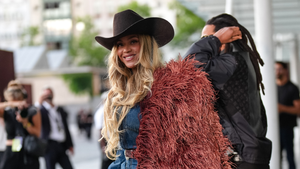Bisexual erasure needs to be a thing of the past

Shutterstock
It’s no secret that members of the LGBTQ+ community are marginalized and stigmatized. However, while many people focus more on the L, G, and T of the spectrum, many people glaze right over the B, and our bisexual brothers and sisters get lost in the fray. We all have stereotypes against us if we identify as queer, but here are some stigmas bisexual people specifically have to face as they move about their lives.
Here are six of the most insidious stigmas about bisexual people — and why they are total BS.
Bisexual people are just confused

Shutterstock
The main thing bisexual people hear when coming out with their identities is that they’re just confused. This also doesn’t just come from cis straight people — members within the queer community are just as likely to say this. However, more people are identifying as bisexual these days, and as recently as 2021, over 3% of adults identified as such.
Let’s just be clear and upfront right away here: Bisexual people are not confused. If anything, they’re more sure of their identities because they’ve likely spent years grappling with choosing an identity while constantly feeling like they have to choose between men or women. They’ve given themselves enough grief on the topic, there’s no need to continue adding any more.
Bisexual people are the same as pansexual people

Shutterstock
Being bisexual and being pansexual have a lot of similarities, yes, but there are a number of differences and they're really not one and the same. You can think of it as a Venn diagram. One of the key differences in the orientations is that bisexual people are attracted to multiple genders, while pansexual people are attracted to a person regardless of their gender. The term pansexual has gained popularity over the last 15 to 20 years, but people who identify as such are more likely to date someone who’s transgendered or intersex than someone who identifies as bisexual.
That said, many people who identify as bisexual also identify as either trans or non-binary themselves and are not inherently transphobic.
More people think bisexuality is "just a phase" than other LGBTQ+ identities

Shutterstock
Anyone who identifies on the LGBTQ+ spectrum has been told at some point it’s just a phase and they’ll "get over it." Since bisexual people have both the cis straight and the homosexual populations against them, they’re much less likely to come out of the closet. According to Stonewall, an LGBTQ+ rights charity, only 36% of bisexual individuals actually come out of the closet as compared to 74% of their gay and lesbian counterparts.
This essentially means the “phase” bisexual individuals are meant to go through is largely dealt with internally, because they fear acceptance from any community. This also increases the likelihood that bisexual individuals will suppress their sexuality for fear of judgment. Again, most people think that bisexual men are using it as a bridge to become gay and they think bisexual women are only doing it to attract men. Neither are true.
Bisexual people get "the best of both worlds"

Shutterstock
Thinking that bisexual people get the “best of both worlds” limits the topic to bisexual people having great sex with both genders. However, the mental health of bisexual people is actually somewhat alarming. Bisexual people have been linked to higher rates of depression as compared to individuals who identify as gay or lesbian, with experiences of anti-bisexual discrimination and attempts at bisexual erasure being major causes of concern.
What’s worse, according to a 2019 report by The Trevor Project, nearly half of bisexual youth considered suicide the prior year. Considering 7% of youth identified as bisexual over the 2% who identified as gay or lesbian, that's significant. The results showed that nearly two out of three bisexual youths felt hopeless, more than one in three reported being bullied, and one in five reported being forced into sexual intercourse. Notably, 21% of bisexual youth reported the latter as compared to 5% of heterosexually-identifying individuals.
Bisexual people are more promiscuous

Shutterstock
Listen, we’re all embracing our sexual nature more and more these days. Bisexual people aren’t any different than anybody else and explore a wide variety of sexual behaviors. It’s no more prevalent here than anywhere else.
Plus, a report by the Centers for Disease Control and Prevention (CDC) published in 2011 stated that little is known regarding the number of sexual partners bisexual men in particular take. They also concluded that it was unclear whether bisexual men had more partners than either heterosexual or homosexual men. The findings found that partner numbers varied based on sexual behavior, identity, and attraction.
So, again: Bisexual people are no more (or less) promiscuous than anybody else.
The bisexual identity is invalid

Shutterstock
As stated above, bisexual erasure is still very much a thing. Monosexism, or the belief that people are either heterosexual or homosexual, remains one of the biggest roadblocks for the bisexual population. It is essentially the binary view of human sexuality that’s behind bi erasure and creates a double closet effect when it comes to biphobia.
In 2020, GLAAD petitioned for the Merriam-Webster dictionary definition to be updated for a more inclusive look on bisexuality with the hopes of fighting against the monosexism that still exists. The updated definition allows for a more accurate and current understanding of the orientation, particularly after they also updated terms like “nonbinary,” “genderqueer,” and “pansexual.”

























































 35 bisexual pop anthems we have on constant repeatYouTube.com/Binoy
35 bisexual pop anthems we have on constant repeatYouTube.com/Binoy












 A couple kisses in the middle of the street during the Christopher Street Day ; Men seen kissing during the 2023 Pride Barcelona Parade.Yerchak Yauhen/SOPA Images/LightRocket via Getty Images; imone Boccaccio/SOPA Images/LightRocket via Getty Images
A couple kisses in the middle of the street during the Christopher Street Day ; Men seen kissing during the 2023 Pride Barcelona Parade.Yerchak Yauhen/SOPA Images/LightRocket via Getty Images; imone Boccaccio/SOPA Images/LightRocket via Getty Images


















